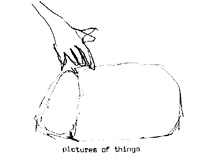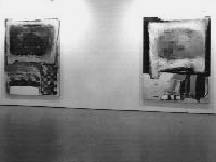- MAIN INDEX | ARTIST INDEX
| October 14 - November 1, 1980 Lynn Hughes
| |
 Lynn Hughes, "Pictures of Things", invitation 1980. 18K |  Lynn Hughes, installation view of "Pictures of Things", 1980. Photo Peter MacCallum. 18K |
| PRESS RELEASE "I am interested in a dense and ambiguous sense of 'thing' that hovers between the animate and the inanimate, prose and paradise, the classic and the mannerist..." A selection of the Montreal artist's recent paintings entitled "Pictures of Things".
Lynn Hughes
Nancy Carroll "Pictures of Things" is the title of Lynn Hughes' recent exhibition of paintings, and it's an accurate one, for the paintings are, in their peculiar way, pictures of things. The emphasis, however, falls on "of", for it speaks of the relationship between picture and thing. Hughes emphasizes the illusionism that painters of the recent past strenuously sought to avoid. She writes: "I am interested in a dense and ambiguous sense of 'thing' that hovers between the animate and inanimate, between prose and paradise, the classic and the mannerist. I don't particularly consider myself a painter but I chose, recently, to paint; as if its going out of style has returned to it some of its power (tension)." The relationship between picture and thing is not as simple as it may seem on first glance. This is true not only of Hughes' work, but also of strictly picturing situations where we can see (and say) "Here's the picture and there's the thing; here's the picture of the running shoe and there's the shoe." Simply understood, there is a relation of one to one correspondence, with the picture functioning as a name of or a sign for the thing. This is, obviously, a paradigm situation. The referential theory of meaning when applied to painting treats painting as if it were an analytical language comprised of a conglomerate of finite and systematised parts. This, of course, overlooks that fact that if painting functions as a language, it functions as a natural language in a complex and expressive way. It is recreated, as it were, in each instance. Where a painting sets up the picture/thing relation in a deliberate manner, it posits such simplicity and so is, in spite of itself, expressive beyond its immediate transparency. In Hughes' paintings there is no such direct correspondence, and yet her things are definitely thing like. They're strong in connotation while clearly constructs of her imagination. The things appear to be derived from ordinary objects, often with the features of several objects worked into one. For instance, there's a thing that looks like a block of ice, or a slab of rock, while at the same time it looks like a human torso. There are things that look derivative of a pedestal sink, a child's sand shovel, a plate, tray, table, rock, bolder and box. Each varies in its degree of likeness to these objects. Some have gone through minor mutations, while others have changed in major ways. These are free associations of which I'm sure there are alternatives. My point is, although the pictures invite us to freely associate, there are limits which are dictated by the limits of the things. Hughes' pictures achieve, through their eccentric particularity, a concreteness that is rarely achieved in so-called "realism". This can be better understood when we consider that if there were corresponding three dimensional objects to go with each picture, they would have to be custom made. But more importantly, even if such a situation were set up, there would remain ambiguities between the pictures and the things. Hughes not only acknowledges the ambiguities of painting; she exploits them. She gives us, as it were, the grammar of representationalism without the sense. She half-heartedly plays with the standard painterly tricks such as the frame within the frame, the horizon line, the background/foreground dichotomy. Dualism--linguistic and perceptual - is both the source and informant of her work. To tackle such a structurally reflective project calls for a strong painterly ability, and probably more importantly, persistence. While the work is conceptually exciting, it isn't as effective as it should be. Hughes seems to have done much thinking in a chair and not enough, yet, in paint.
| |